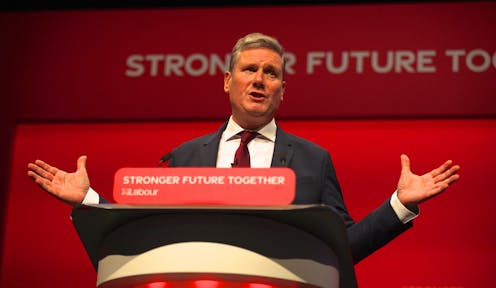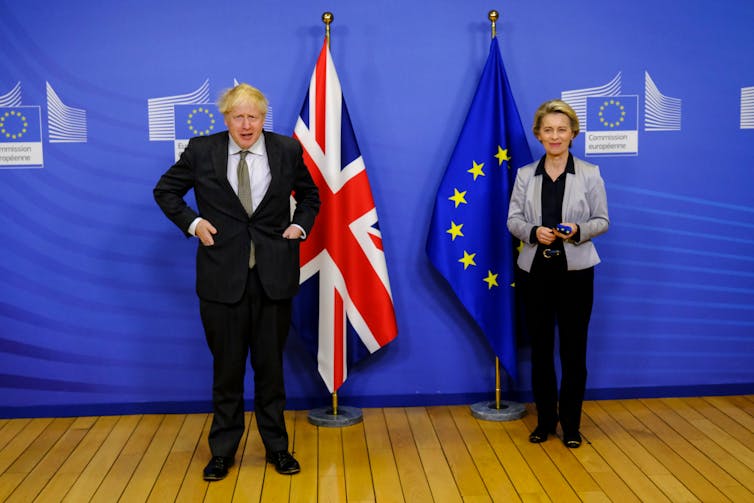
In launching Labour’s manifesto, Keir Starmer sought to shed his party’s “tax and spend” image. Instead, Starmer pressed home that Labour’s core mission is to increase UK economic growth – the manifesto mentions the term more than 200 times.
Some readers may recall Labour’s 1964 manifesto, whose theme tune was Let’s Go with Labour. Back then, growth was supposed to arrive via the “white heat of technology”.
All governments want economic growth. Higher growth (measured as gross domestic product or GDP) raises living standards and provides a way to improve public services without unnecessary tax rises.
Yet over the last 50 years, successive UK governments have presided over declining growth rates in real GDP per person. Since 1974, no UK administration has been able to better the much-maligned Jim Callaghan government’s growth record (notwithstanding the infamous “winter of discontent”).
Since the 2008 financial crisis, UK growth has been elusive. If GDP per person had grown at its pre-crisis trend it has been estimated every UK citizen would be around £14,000 better off per year in real terms. What’s more, the UK has just emerged from nearly two years of falling or stagnant GDP per person .
Much of the UK’s poor growth stems from weak productivity (that is, output per hour worked), which since 2008 has significantly lagged behind that of other major G7 economies. Related to this is a very poor record on private and public investment (a key component of GDP).
According to a recent report from the Institute for Public Policy Research (IPPR), the UK has trailed the major G7 economies on business investment since the mid-1990s, and now ranks 28th of 31 OECD countries. British employees are often working with outdated equipment and, in short, the UK has become a stagnant nation.
Labour’s growth plans
Labour has committed to a new industrial strategy, backed by a statutory body – a re-established Industrial Strategy Council – to offer expert advice and critical appraisal of projects. The approach will be to build on the UK’s strengths such as professional services, advanced manufacturing and the creative sectors, but also financial services. However, policies favouring the City could hamper attempts to level up and reduce the UK’s wide regional inequalities.
A key instrument will be a new £7.3 billion National Wealth Fund, which will look to direct public investment in areas such as ports and green technologies.
The aim is to “crowd in” three times as much private investment in these potential high-growth sectors. Raising UK investment is a key theme of the manifesto, and shadow chancellor Rachel Reeves has promised to host a global investment summit within 100 days of taking office.
Labour has also promised to invest £1.7 billion a year in a state energy company, Great British Energy, to roll out renewables and secure supplies of clean energy. There are opportunities here and, critically, a role for state support where the market is not moving fast enough.
The UK has a competitive advantage in the generation, storage and low-carbon technologies and processes, especially in nuclear and offshore wind. Sadly, it has yet to leverage this into building a stronger supply chain, which has been something of a missed opportunity. Failure to invest sufficiently could mean the UK loses out in the global green technology race.
Labour has also said it will look to reform business rates to ensure high streets can remain competitive with online retailers. A Regulation Innovation Office will look to expedite approval times for new products to get them to market earlier. Planning rules are also to be updated with the aim of “slashing red tape” to build more homes.
Finally, Labour is emphasising the importance of providing stability for business. Given the often chaotic and uncertain political environment of the last few years, this should not be underplayed, especially in bolstering business confidence. However, on its own, it is unlikely to shift the dial on investment sufficiently to meet the scale of the challenge.
Lack of ambition and Brexit challenges
Several of Labour’s policies have been welcomed by business as a step in the right direction. Reviving the industrial strategy will also bring the UK in line with other leading economies, including the US and the EU.
Nevertheless, many economists question whether Labour’s ambitions will actually be met, given the modest scale of proposed public investment. The IPPR notes that Labour still plans to cut total public investment over the next Parliament – by more than the entire Conservative government of 2010-24.
This is because Labour has signed up to meeting the current government’s fiscal rules. But this self-imposed fiscal constraint will severely limit Labour’s ability to grow the economy.

The elephant in the room however is the UK’s trading relationship with the EU. Brexit has significantly hit UK goods trade and investment – estimates put the long term hit to UK GDP at 5-6%.
Yet Labour has ruled out rejoining the European single market, although it hopes to secure some concessions to the existing EU-UK Trade and Cooperation Agreement. These could be welcome in areas like chemicals regulation but will do little to lift overall growth, especially as the EU has ruled out allowing the UK to “cherry pick” deals.
Starmer would be wise to remember international factors have scuppered previous Labour governments’ efforts to generate growth. These include dealing with the ‘gnomes of Zurich’ and a sterling devaluation in 1967, the IMF crisis of 1976 and the global financial crisis of 2008.
If Labour wants to avoid the stop-go growth policies of the past, it will need to deal with Brexit’s drag on growth.
Phil Tomlinson receives funding from the Engineering and Physical Sciences Research Council (EPSRC) for Made Smarter Innovation: Centre for People-Led Digitalisation.
David Bailey receives funding from the Economic and Social Research Council’s (ESRC) UK in a Changing Europe programme under grant number ES/X005844/1.
This article was originally published on The Conversation. Read the original article.







